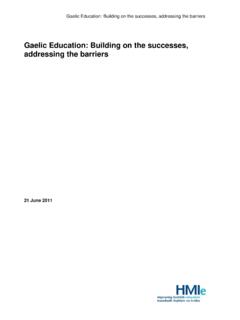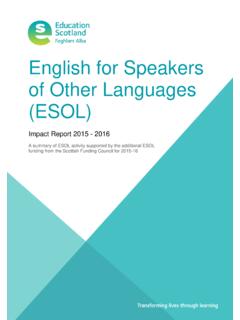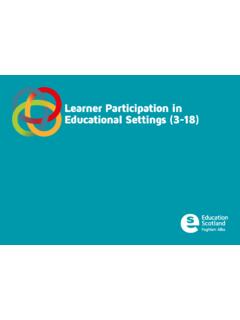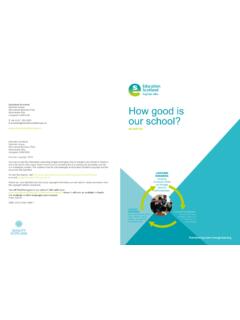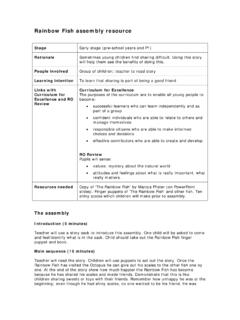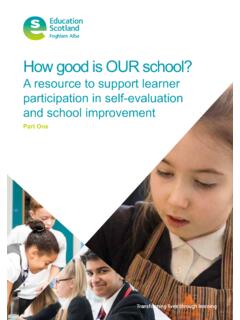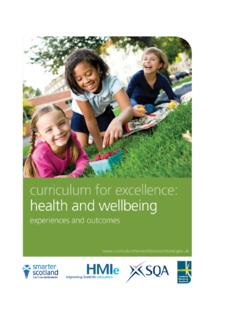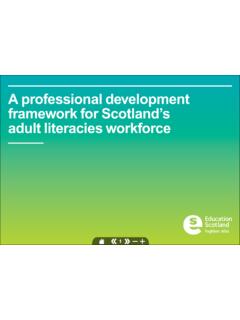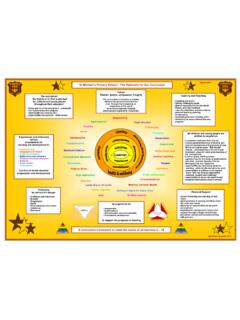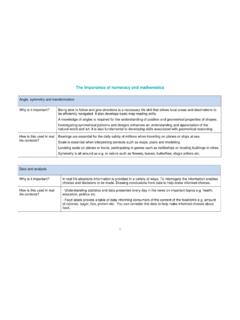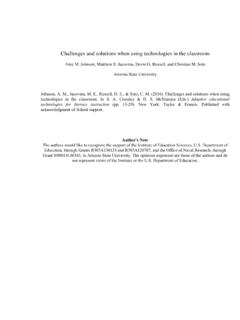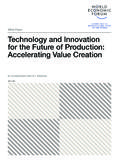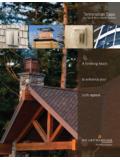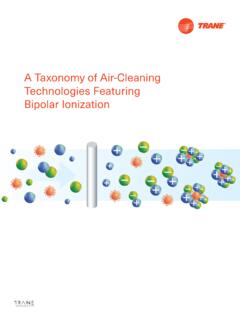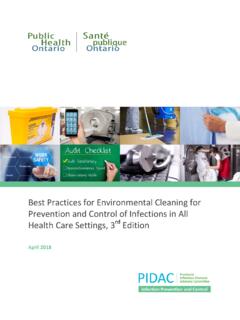Transcription of Benchmarks Technologies - Education Scotland
1 Benchmarks Technologies March 2017. 1. Education Scotland Guidance on using Benchmarks for Assessment March 2017. Education Scotland s Curriculum for Excellence (CfE) Statement for Practitioners (Aug 2016) stated that the two key resources which support practitioners to plan learning, teaching and assessment are: Experiences and Outcomes Benchmarks Benchmarks have been developed to provide clarity on the national standards expected within each curriculum area at each level. They set out clear lines of progression in literacy and English and numeracy and mathematics, and across all other curriculum areas from Early to Fourth Levels (First to Fourth Levels in Modern Languages).
2 Their purpose is to make clear what learners need to know and be able to do to progress through the levels, and to support consistency in teachers and other practitioners professional judgements. Skills development is integrated into the Benchmarks to support greater shared understanding. An understanding of skills and how well they are developing will enable learners to make links between their current learning and their future career options and employment. Benchmarks draw together and streamline a wide range of previous assessment guidance (including significant aspects of learning, progression frameworks and annotated exemplars).
3 Into one key resource to support teachers and other practitioners professional judgement of children s and young people s progress across all curriculum areas. Benchmarks have been designed to support professional dialogue as part of the moderation process to assess where children and young people are in their learning. They will help to support holistic assessment approaches across learning. They should not be ticked off individually for assessment purposes. Benchmarks for literacy and numeracy should be used to support teachers professional judgement of achievement of a level. In other curriculum areas, Benchmarks support teachers and other practitioners to understand standards and identify children s and young people s next steps in learning.
4 Evidence of progress and achievement will come from a variety of sources including: observing day-to-day learning within the classroom, playroom or working area;. observation and feedback from learning activities that takes place in other environments, for example, outdoors, on work placements;. coursework, including tests;. learning conversations; and planned periodic holistic assessment. 1. Benchmarks in curriculum areas Benchmarks in each curriculum area are designed to be concise and accessible, with sufficient detail to communicate clearly the standards expected for each curriculum level. Teachers and other practitioners can draw upon the Benchmarks to assess the knowledge, understanding, and skills for learning, life and work which children are developing in each curriculum area.
5 In secondary schools, Benchmarks can support subject specialist teachers in making robust assessments of learners progress and the standards they achieve. They will help teachers ensure that learners make appropriate choices and are presented at an appropriate level for National Qualifications in the senior phase. This can help avoid excessive workload for teachers and unnecessary assessments for learners. For example, learners should have achieved relevant Fourth level Experiences and Outcomes before embarking on the National 5 qualifications. Schools should take careful account of this when options for S4 are being agreed.
6 Benchmarks should be used to help with these important considerations. Literacy and numeracy In literacy and numeracy, Benchmarks support teachers professional judgement of achievement of a level. Teachers professional judgements will be collected and published at national, local and school levels. It is important that these judgements are robust and reliable. This can only be achieved through effective moderation of planning learning, teaching and assessment. Achievement of a level is based on teacher professional judgement, well informed by a wide range of evidence. Benchmarks should be used to review the range of evidence gathered to determine if the expected standard has been achieved and the learner has: achieved a breadth of learning across the knowledge, understanding and skills as set out in the experiences and outcomes for the level.
7 Responded consistently well to the level of challenge set out in the Experiences and Outcomes for the level and has moved forward to learning at the next level in some aspects; and demonstrated application of what they have learned in new and unfamiliar situations. It is not necessary for learners to demonstrate mastery of every individual aspect of learning within Benchmarks at a particular level and before moving on to the next level. However, it is important that there are no major gaps in children s and young people's learning when looking across the major organisers in each curriculum area. 2. Planning learning, teaching and assessment using the Benchmarks In addition to the Curriculum for Excellence (CfE) Statement for Practitioners from HM Chief Inspector of Education , August 2016 on the purpose and use of Benchmarks , teachers and other practitioners should note the following advice.
8 KEY MESSAGES WHAT TO DO KEY MESSAGES WHAT TO AVOID. Use literacy and numeracy Benchmarks Avoid undue focus on individual to help monitor progress towards Benchmarks which may result achievement of a level, and to support in over-assessing or recording overall professional judgement of when of learners progress. a learner has achieved a level. Become familiar with other curriculum Avoid the requirement to spend time area Benchmarks over time. collating excessive evidence to assess learners achievement. Use Benchmarks to help assess whether There is no need to provide curriculum learners are making suitable progress level judgements in all curriculum areas towards the national standards expected stick to literacy and numeracy.
9 And use the evidence to plan their next, challenging steps in learning. Discuss Benchmarks within and Do not create excessive or elaborate across schools to achieve a shared approaches to monitoring and tracking. understanding of the national standards expected across curriculum areas. Do not assess Benchmarks individually. Plan periodic, holistic assessment of children s and young people s learning. Do not tick off individual Benchmarks . 3. Benchmarks Early Level Technologies Experiences and Outcomes Curriculum Organisers for planning learning, teaching Benchmarks to support practitioners' professional judgement and assessment Using digital I can explore digital Technologies Recognises different types of digital technology.
10 Products and and use what I learn to solve Identifies the key components of different types of digital technology. services in a problems and share ideas and Logs on to a preferred device with a given password. variety of contexts thoughts. Identifies icons for different applications. to achieve a TCH 0-01a Opens and close a pre-saved file. purposeful Identifies and consistently use the close icon. outcome Uses digital Technologies in a responsible way and with appropriate care. Digital Literacy Searching, I can use digital Technologies Identifies and uses images and key words when searching for specific information.
